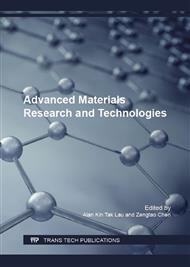[1]
P. Yuhua, P.J. Witt, X. Dongsheng, CFD simulation of free surface flow and heat transfer of liquid slag on a spinning disc for a novel dry slag granulation process, Progress in Computational Fluid Dynamics, 10 (2010) 292-299.
DOI: 10.1504/pcfd.2010.035362
Google Scholar
[2]
S.J. Pickering, N. Hay, T.F. Roylance, G.H. Thomas, New process for dry granulation and heat-recobery from molten blast-furnace slag, Ironmaking & Steelmaking, 12 (1985) 14-21.
Google Scholar
[3]
T. Mizuochi, T. Akiyama, T. Shimada, E. Kasai, J. Yagi, Feasibility of Rotary Cup Atomizer for slag granulation, Isij International, 41 (2001) 1423-1428.
DOI: 10.2355/isijinternational.41.1423
Google Scholar
[4]
H. Purwanto, T. Mizuochi, H. Tobo, M. Takai, T. Akiyama, Characteristics of glass beads from molten slag produced by Rotary Cup Atomizer, Materials Transactions, 45 (2004) 3286-3290.
DOI: 10.2320/matertrans.45.3286
Google Scholar
[5]
J. Liu, Q. Yu, P. Li, W. Du, Cold experiments on ligament formation for blast furnace slag granulation, Applied Thermal Engineering, 40 (2012) 351-357.
DOI: 10.1016/j.applthermaleng.2012.01.063
Google Scholar
[6]
X. Wang, Simulating experiment for the blast furnace slag dry granulation (2008).
Google Scholar
[7]
T.J. Bhatelia, R.P. Utikar, V.K. Pareek, M.O. Tade, Characterizing liquid film thickness in spinning disc reactors, 7th International Conference on CFD in the Minerals and Process Industries. Melbourne, Australia, December, 2009, pp.9-11.
Google Scholar
[8]
Y. Pan, P. Witt, B. Kuan, D. Xie, Effect of flow and operating parameters on the spreading of a viscous liquid on a spinning disc, Ninth International Conference on CFD in the Minerals and Process Industries, 2012, pp.10-12.
Google Scholar
[9]
D. Wang, X. Ling, H. Peng, Theoretical analysis of free-surface film flow on the rotary granulating disk in waste heat recovery process of molten slag, Applied Thermal Engineering, 63 (2014) 387-395.
DOI: 10.1016/j.applthermaleng.2013.11.033
Google Scholar
[10]
Y. Qin, X. Lv, C. Bai, G. Qiu, P. Chen, Waste Heat Recovery from Blast Furnace Slag by Chemical Reactions, Jom, 64 (2012) 997-1001.
DOI: 10.1007/s11837-012-0392-3
Google Scholar
[11]
H. Purwanto, T. Akiyama, Hydrogen production from biogas using hot slag, Int J Hydrogen Energ, 31 (2006) 491-495.
DOI: 10.1016/j.ijhydene.2005.04.021
Google Scholar


